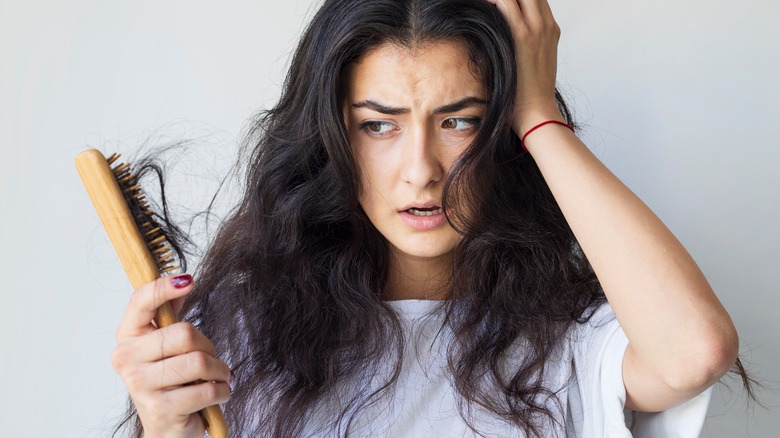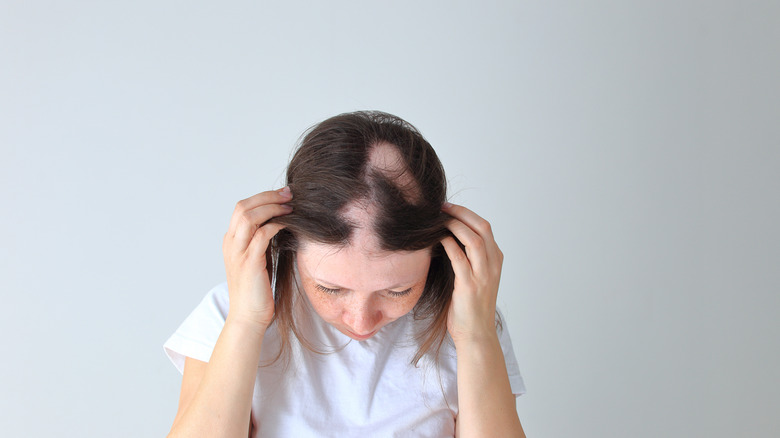Shedding Vs. Hair Loss: How To Know If Losing Strands Is Serious
We may receive a commission on purchases made from links.
Noticed a few more loose strands than usual left on your brush? While the sight of your own hair falling away from your head leads most people to panic, the truth is it's normal to lose some hair every day. Each hair on your head is at a different stage of its life cycle, which runs between the anagen phase, where the hair grows around one centimeter per month, to the telogen phase, where the hair rests as it prepares to detach from the scalp (via Healthline). It's estimated that between 8% and 9% of your hair is in this detaching phase at any given time.
Thinning or balding hair is typically associated with men as they age, but women tend to lose more hair per day than men on average. When part of the normal hair cycle, losing hair is nothing to worry about. However, there are certain signs related to your hair falling out that may suggest it's time to investigate further. Regular shedding and serious hair loss can appear similar at first, but while shedding is normal, hair loss indicates a deeper problem that needs addressing.
What is hair shedding?
Hair shedding is a normal part of the hair cycle and takes place in the telogen detachment phase. The average person has 100,000 hairs on their head and will lose around 100 strands every day as part of the cycle (via Shaz & Kiks). At this rate, hair shedding is no cause for alarm. Sometimes, you may notice an increase in hair shedding, losing more than 100 hairs per day. This doesn't necessarily point to a larger problem, as there are several benign causes of excessive hair shedding. One of these is stress, which leads to an increase of androgen — a cause of graying hair and hair falling out. Hormonal imbalance can also increase the amount of hair you shed, as can hormonal changes associated with menopause.
The American Academy of Dermatology Association explains that excessive hair shedding can also occur as a result of losing more than 20 pounds, undergoing an operation, giving birth, or experiencing a high fever. Increased hair shedding usually stops on its own after the trigger has cleared up, but in the meantime, you can promote healthy hair by giving your scalp weekly treatments, taking hair supplements, and engaging in self-care (via Vegamour). The primary way to differentiate hair shedding from more serious hair loss is by measuring its duration. If you continue to lose more hair than you usually do over an extended period of time, you may be experiencing hair loss.
How to recognize hair loss
Hair loss describes hair that has completely stopped growing (via Simply Wigs). You may be experiencing hair loss if you continue to lose a significant amount of hair, or if you notice bald spots or patches of thin hair on your head where there were none before. According to the Cleveland Clinic, there are three types of hair loss: anagen effluvium, caused by the poisoning of the hair follicle; telogen effluvium, caused by more than 10% of hair follicles reaching the telogen detachment phase; and androgenetic alopecia, which is the most common kind of hair loss. This is characterized by hair thinning on the sides and top of the scalp. Factors that can lead to these conditions include immune system disorders, irritating hairstyles, harmful hair products, and hereditary hair loss.
In most cases, hair will start growing again when the underlying issue is resolved. For example, in the case of anagen effluvium, which usually occurs as a result of chemotherapy, hair will grow back when treatment stops. The Mayo Clinic recommends having a doctor or dermatologist diagnose the exact issue, which will then guide you toward the correct treatment path. There are several medications available to treat hereditary baldness, including Minoxidil (Rogaine). A hair transplant can also help with hair loss, as can laser therapy, although more research is needed to confirm the long-term effects of the latter. If you do start to notice your hair thinning or falling out for an extended period of time, don't hesitate to investigate with your healthcare provider. If you are experiencing hair loss, you'll need to address the underlying problem before your hair will start growing again.


